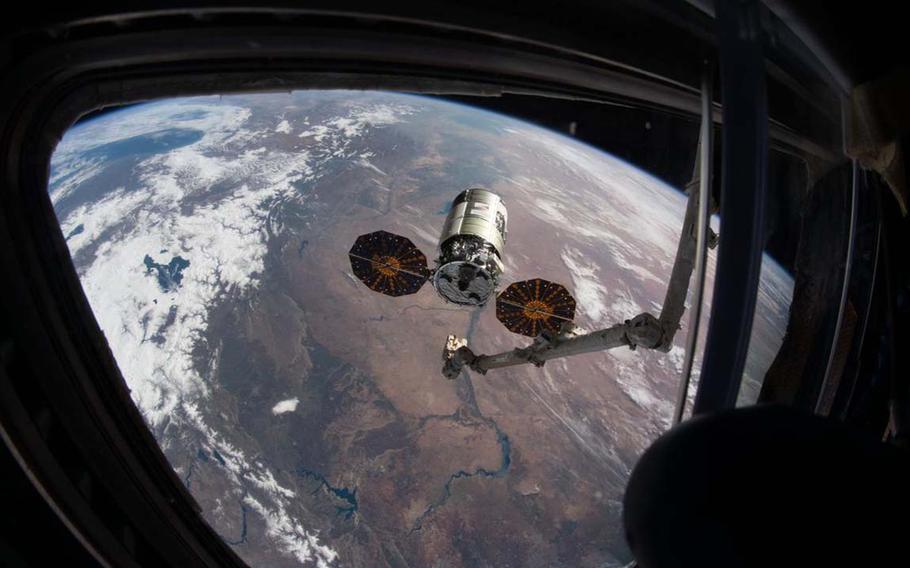
This file image shows Northrop Grumman’s Cygnus cargo spacecraft as it is grabbed by the Canadarm2 robotic arm at the International Space Station. (NASA)
(Tribune News Service) — SpaceX is set to lend a hand once more providing launch services for its competitors as a Falcon 9 rocket is set to take up a Northrop Grumman spacecraft on a resupply mission to the International Space Station.
The Cygnus spacecraft on the NG-20 mission loaded with more than 8,200 pounds of supplies and science equipment will be the first resupply launch of the year for the orbiting ISS. It’s set to lift off from Cape Canaveral Space Force Station’s Space Launch Complex 40 at 12:07 p.m. A backup launch option falls to Thursday at 11:18 a.m.
Space Launch Delta 45’s weather squadron forecasts a 95% chance for good launch conditions, which falls to 90% if delayed to Thursday.
The Falcon 9’s first-stage booster is making its 10th flight and will make a recovery landing back on land at Canaveral’s Landing Zone 1, which means its sonic boom might be heard along the Space Coast and other parts of Central Florida.
Among the cargo are more than 20 science payloads including a 3D metal printing investigation, an artificial retina experiment, optical fiber production project, and a pair of robotic arms to investigate space surgery, according to the ISS National Lab.
“We’ll be looking at the ability to perform surgery in space that is controlled from doctors on the ground,” said NASA’s Meghan Everett, a deputy scientist for the ISS program. “Don’t worry, we’re not doing surgery quite yet on the astronauts in space. We’ll be using rubber bands to mimic human tissue.”
Also flying up are supplies for the ISS such as spare parts for its urine processor, oxygen generator, solar power arrays and exercise equipment. Food flying up includes apples, citrus, cheese, hazelnut spread, coffee, hummus and “lots of ice cream,” said NASA’s Dina Contella, operations integration manager for the ISS program.
“Don’t tell the crew, some of that’s a surprise,” she said. “We have things like chocolate ice cream of course, but even some fancier like chocolate brownie and some other mint chip and other things that were requested by them.”
The ice cream along with time-sensitive science is being loaded the day of launch. SpaceX built a special fairing door for its Falcon 9 so teams will be able to access the Cygnus as part of the launch plan.
Cygnus is expected to arrive to the ISS early Thursday when it will be grappled by the Canadarm2 and be attached to the Unity module’s Earth-facing port for cargo unloading by the Expedition 70 crew. Cygnus will spend about 100 days attached to the ISS before it is released to burn up in Earth’s atmosphere.
This is the first of at least three missions SpaceX will fly for Northrop Grumman after that company ran out of usable Antares rockets, which have been used to fly most of Cygnus’ previous 19 resupply missions to the ISS since 2010, all from launch facilities in Virginia. It did launch from the Space Coast once before on board a United Launch Alliance Atlas V back in 2016.
Originally SpaceX and Orbital ATK were awarded NASA’s Commercial Resupply Services contracts and SpaceX continues to fly its cargo Dragon spacecrafts on resupply runs to the ISS. Each company has a contract to send up cargo twice a year. Northrop Grumman acquired Orbital ATK in 2018.
Its supply of Antares rockets though hit a double hurdle as federal law required companies to use American-made engines for certain missions and that meant steering away from Russian-made RD-181 engines. But also a major portion of the Antares is fabricated by a Ukrainian company, and supply chain issues tied to Russia’s invasion of Ukraine led Northrop to announce in 2022 it would partner with Firefly Aerospace to create a new version of its Antares rocket, but that won’t be available until at least 2025.
Thus SpaceX stepped in to fill in the gap.
“It’s a tremendous honor to be part of this team,” said SpaceX chief engineer Bill Gerstenmaier. “It’s neat effort to see how all the spaceflight participants come together.”
It isn’t the first time SpaceX has been able to complete the job when other companies couldn’t, even if it’s SpaceX competition.
The invasion of Ukraine stymied plans for internet satellite company OneWeb to launch from Russia, and instead shifted to SpaceX and India’s space agency to perform six remaining launches to complete its constellation, which is similar to SpaceX’s Starlink service.
And SpaceX will even lend a hand to Elon Musk’s frenemy Jeff Bezos as Amazon recently contracted for some assistance in getting its own massive internet satellite constellation Project Kuiper into orbit.
“We treat everyone fairly,” Musk said with a small laugh during a January meeting with SpaceX employees.
SpaceX has also been the beneficiary of other companies’ delays, such as picking up the slack for crewed missions to the ISS as part of NASA’s Commercial Crew Program as competitor Boeing’s CST-100 Starliner has fallen years behind.
Crew Dragon was supposed to trade off duties with Starliner so each launched one mission per year sending up astronauts for six-month stays on board the station, but SpaceX is now prepping for its eighth rotational mission since 2020 while Boeing is still aiming for its first crewed test flight, which is slated for April.
SpaceX managed 96 launches of its Falcon 9 and Falcon Heavy rockets in 2023.
“With Falcon we have achieved the most launches of any rocket in a single year ever,” Musk said. “We’re aiming for maybe as much as 150 flights this year.”
©2024 Orlando Sentinel.
Visit orlandosentinel.com.
Distributed by Tribune Content Agency, LLC.